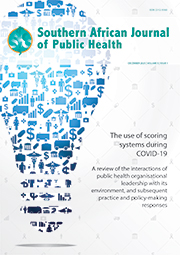Research

Prevalence and risk factors of smoking among healthcare workers and non-healthcare workers in Zambezi region, Namibia: A cross-sectional study
Abstract
Background. Smoking is a major risk factor for non-communicable diseases, and remains a significant public health challenge in many low- and middle-income countries, including Namibia.
Objective. To estimate the prevalence of smoking and its associated risk factors among healthcare workers (HCWs) and non-HCWs in Zambezi region, Namibia.
Methods. An exploratory cross-sectional survey was conducted between March and October 2020 among residents of the eight constituencies of Zambezi region. A total of 461 respondents who had been residents of the selected constituencies for over 5 years and were aged between 17 and 60 years were selected for the study. The main outcome measure was current cigarette smoking status. Descriptive statistics were used to summarise the sociodemographic characteristics of the respondents. We stratified data analysis according to whether individuals were health workers or non-health workers. A bivariate Pearson χ2 test was used to determine the association between sociodemographic characteristics and smoking status. Statistically significant variables in the bivariate analysis were used as predictors in the univariate and multivariate models.
Results. The response rate of potential participants was 95% (n=434). The mean (standard deviation) age of participants was 32.5 (11.34) years. Significant relationships were observed between smoking status and area of residency (constituency), gender, age category, level of education, age of onset of smoking and daily smoking frequency. The majority of smokers (n=108) were non-HCWs, with males the majority (n=62). Age (p=0.001), education levels (p=0.001) and area of residency (p=0.022) were highly associated with smoking among non-HCWs, while marital status was associated with smoking among HCWs (p=0.013). In the final multivariate model, the odds of smoking among female non-HCWs were significantly lower (odds ration (OR) 0.386; 95% confidence interval (CI) 0.228 - 0.655). Furthermore, the odds of smoking among this same group were lower among those who had secondary-level education (OR 0.178; 95% CI 0.0659 - 0.483), post-secondary (OR 0.117; 95% CI 0.0412 - 0.330) and first-stage tertiary (OR 0.306; 95% CI 0.106 - 0.881) compared with those who had primary school education.
Conclusion. The smoking prevalence among non-HCWs and HCWs working in Zambezi included in the study was similar to that of the general Namibian population, but higher than that in neighbouring countries within the Southern African Development Community. The results showed a need for the establishment of specific smoking-related strategies that target HCWs to address smoking use parallel to the running strategies of non-HCWs, which would ultimately decrease smoking prevalence and improve health.
Authors' affiliations
S K Mahoto, School of Public Health, Faculty of Health Science, University of Namibia, Oshakati, Namibia
H K Mitonga, School of Public Health, Faculty of Health Science, University of Namibia, Oshakati, Namibia
O Oladimeji, Department of Public Health, Walter Sisulu University, Mthatha, South Africa
Full Text
Cite this article
Article History
Date published: 2022-01-28
Article Views
Full text views: 758

.jpg)


Comments on this article
*Read our policy for posting comments here